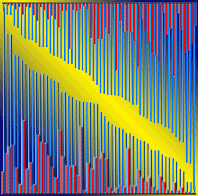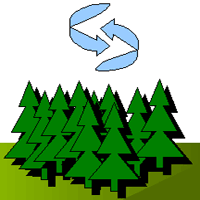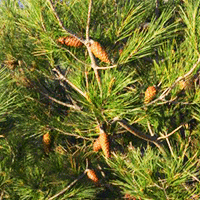
Assessing escapes from short rotation plantations of the invasive tree species Robinia pseudoacacia L. in Mediterranean ecosystems: a study in central Italy
Roberto Crosti (1-2) , Emiliano Agrillo (3), Lorenzo Ciccarese (4), Riccardo Guarino (5), Pierluigi Paris (6), Anna Testi (3)
iForest - Biogeosciences and Forestry, Volume 9, Issue 5, Pages 822-828 (2016)
doi: https://doi.org/10.3832/ifor1526-009
Published: May 25, 2016 - Copyright © 2016 SISEF
Research Articles
Abstract
Black locust (Robinia pseudoacacia L.) is a fast growing tree species native to temperate North America, and widely diffused and naturalized in Europe. It is one of the candidate species for establishing bioenergy plantations on marginal lands in temperate and sub-Mediterranean regions. This potential is in contrast to its well-known invasive habit, leading to a potential damage to plant biodiversity in many European countries. Advise against black locust plantation in regions where it is already invasive has been issued by several international reports, as well as the adoption of mitigation measures (e.g., “containment” buffer zones) to prevent the spread of the species into natural and semi-natural habitats. In the Mediterranean basin, however, no studies have been carried out aimed at quantifying the escape rate of black locust saplings from plantation stands and its recruitment into natural habitats, together with the effectiveness of a buffer zone in reducing the spread. In this study we investigated the spread of black locust along 35 transects surrounding three 20-year- old plantations and including three different land cover types: abandoned arable land, semi-natural woodland and a buffer zone (orchards) with a low degree of farming input. In addition, the effect of soil disturbance on seed propagation was investigated. Our results demonstrate that the density of black locust regeneration is strongly affected by the land cover, abandoned agricultural land being the most prone to black locust colonization. Contrastingly, the spread was minimal in the buffer zone and negligible in semi-natural woodland. During the investigated year, seed generative propagation was also negligible. The semi-natural woodland seems to resist well to black locust invasion, though further observations are needed to assess the consequences of stand harvesting disturbance as well, according to local standard forest management. Buffer zones seem to be very effective in controlling black locust invasion. Best management practices, with active farming inputs, are also discussed.
Keywords
False Acacia, Mediterranean Region, Risk Assessment, Containment, EU Regulation, Invasive Species
Authors’ Info
Authors’ address
ISPRA-IV Dipartimento, STS Palermo (Italy)
IUCN-CEM- Ecosystems and Invasive Species (Italy)
Anna Testi
Dip. Biologia Ambientale, La Sapienza Università degli Studi di Roma (Italy)
ISPRA, Dipartimento Difesa della Natura; Roma (Italy)
Dip. STEBICEF, Università degli Studi di Palermo (Italy)
CNR-IBAF Porano (Italy)
Corresponding author
Paper Info
Citation
Crosti R, Agrillo E, Ciccarese L, Guarino R, Paris P, Testi A (2016). Assessing escapes from short rotation plantations of the invasive tree species Robinia pseudoacacia L. in Mediterranean ecosystems: a study in central Italy. iForest 9: 822-828. - doi: 10.3832/ifor1526-009
Academic Editor
Andrea Cutini
Paper history
Received: Dec 11, 2014
Accepted: Jan 28, 2016
First online: May 25, 2016
Publication Date: Oct 13, 2016
Publication Time: 3.93 months
Copyright Information
© SISEF - The Italian Society of Silviculture and Forest Ecology 2016
Open Access
This article is distributed under the terms of the Creative Commons Attribution-Non Commercial 4.0 International (https://creativecommons.org/licenses/by-nc/4.0/), which permits unrestricted use, distribution, and reproduction in any medium, provided you give appropriate credit to the original author(s) and the source, provide a link to the Creative Commons license, and indicate if changes were made.
Web Metrics
Breakdown by View Type
Article Usage
Total Article Views: 51668
(from publication date up to now)
Breakdown by View Type
HTML Page Views: 42417
Abstract Page Views: 3513
PDF Downloads: 4234
Citation/Reference Downloads: 52
XML Downloads: 1452
Web Metrics
Days since publication: 3489
Overall contacts: 51668
Avg. contacts per week: 103.66
Citation Metrics
Article Citations
Article citations are based on data periodically collected from the Clarivate Web of Science web site
(last update: Mar 2025)
Total number of cites (since 2016): 20
Average cites per year: 2.00
Publication Metrics
by Dimensions ©
Articles citing this article
List of the papers citing this article based on CrossRef Cited-by.
References
Espansione delle colture da biomassa sul territorio italiano: incognite legate all’introduzione di specie aliene potenzialmente invasive. [Expansion of biomass crops in Italy: uncertainties associated with the introduction of potentially invasive alien species]. In: Proceedings of the Meeting “Colture a scopo energetico e ambiente. Sostenibilità, diversità e conservazione del territorio” (Forconi V, Cipollaro S, Visicchio F, Crosti R eds). APAT, Rome, Italy, pp. 49-58. [in Italian]
Gscholar
Use of “native species” as a bioenergy crop in the Mediterranean basin. Concerns regarding invasive traits of some domesticated taxa: the case of Cardoon (Cynara cardunculus). In: Proceedings of the “2nd International Workshop on Invasive Plants in the Mediterranean Type Regions of the World” (Brunel S, Uludag A, Fernandez-Galiano Brundu G eds). Trabzon (Turkey) 2-6 Aug 2010, pp. 389-391.
Online | Gscholar
Invasiveness of biofuel crops and potential harm to natural habitats and native species. Report T-PVS/Inf 6, Convention on the Conservation of European Wildlife and Natural Habitats, Council of Europe, Strasbourg, France, pp. 23.
Gscholar
Handbook of alien species in Europe. Springer, Dordrecht, Netherlands, pp. 379.
Gscholar
Progetto boschi del Parco regionale dei Colli Euganei. [Project woodlands of the regional park of the Colli Euganei]. Parco regionale dei Colli Euganei, Este, Padua, Italy, pp. 212. [in Italian]
Gscholar
La flora. [Flora]. “Conosci l’Italia vol. 2”. Touring Club Italiano, Milan, Italy, pp. 272. [in Italian]
Gscholar
La robinia. [The robinia]. In: “L’arboricoltura da legno: un’attività produttiva al servizio dell’ambiente” (Minotta G ed). Edizioni Avenue Media, Bologna, Italy, pp. 38-42. [in Italian]
Gscholar
Downy-oak woods of Italy: phytogeographical remarks on a controversial taxonomic and ecologic issue. In: “Warm-temperate deciduous forests around the Northern Hemisphere” (Box E, Fujiwara K eds). Geobotany Studies, Springer International Publishing, Switzerland, pp. 139-151.
CrossRef | Gscholar
Climate change 2014: mitigation of climate change. Contribution of working Group III to the Fifth Assessment Report of the Intergovernmental Panel on Climate Change (Edenhofer O, Pichs-Madruga R, Sokona Y, Farahani E, Kadner S, Seyboth K, Adler A, Baum I, Brunner S, Eickemeier P, Krieman B, Savolainen J, Schlömer S, Stechow C, Zwickel T, Minx Ceds J eds). Cambridge University Press, Cambridge, UK and New York, NY, USA, pp. 1075.
Gscholar
Biologische Invasionen: Neophyten und Neozoen in Mitteleuropa. [Biological invasions: new plant and animal species in Central Europe] (2nd edn). Ulmer, Stuttgard, Germany, pp. 492. [in German]
Gscholar
Analisi degli accrescimenti di Robinia pseudoacacia L. sui Monti Peloritani (ME). [Growth analysis of Robinia pseudoacacia on the Monti Peloritani (ME, Sicily]. In: “Applicazioni e prospettive per la Ricerca Forestale Italiana” (Bucci G, Minotta G, Borghetti M eds). Ed. Avenue media, Bologna, Italy, pp. 77-79. [in Italian]
Gscholar
Agriophyten in der vegetation Mitteleuropas. Bundesforschungsanstalt für Naturschutz und Landschaftsökologie [Naturalized species in the vegetation of Central Europe. Federal Research Centre for Nature Conservation and Landscape Ecology]. Münster-Hiltrup, Vertrieb, Landwirtschaftsverlag, Bonn-Bad Godesberg, Germany, pp. 185. [in German]
Gscholar
Robinia pseudoacacia L. Una specie da valorizzare o un’aliena da combattere? [Robinia pseudoacacia L. An alien tree species to be implemented or eradicated?] Sherwood 93: 35-44. [in Italian]
Gscholar
La robinia a turno breve vince nelle zone marginali [Robinia short rotation wins in marginal areas]. Terra e Vita 48: 79-82. [in Italian]
Gscholar
Rapporto sullo stato delle foreste in SICILIA 2010 [State of forests of the Region Sicily 2010]. Coordinamento Dipartimento Regionale Comando Corpo Forestale, Regione Sicilia, Palermo, Italy, pp. 132. [in Italian]
Gscholar
Robinien. Bäume Nordamerikas. Von Alligator-Wacholder bis Zucker-Ahorn. Alle charakteristischen Arten im Porträt. [Robinia. Trees of North America. From Alligator Juniper (Juniperus deppeana Steud.) to Sugar Maple (Acer saccharum Marshall). A portrait of the most representative species] (Roloff H, Weisgerber H, Lang U, Stimm B eds). Wiley-VCH Verlag, Weinheim, Germany, pp. 215-236. [in German]
Gscholar
Recommendation no. 141 of the Standing Committee of the Convention on the Conservation of European Wildlife and Natural Habitats (Bern Convention) Council of Europe, adopted on 26 November 2009, on potentially invasive alien plants being used as biofuel crops. Council of Europe, Strasbourg, France, pp. 1.
Online | Gscholar
Le stime di superficie 2005 - Prima parte. Inventario Nazionale delle Foreste e dei Serbatoi Forestali di Carbonio [Area Estimation, 2005 - First part. National Inventory of Forests and forest Carbon pools]. MiPAAF - Corpo Forestale dello Stato - Ispettorato Generale, CRA-ISAFA, Trento, Italy, pp. 389. [in Italian]
Gscholar
A guide to forest seed handling with special reference to the tropics. FAO Forestry Paper, 20/2. FAO, Rome, Italy, pp. 379.
Gscholar

















